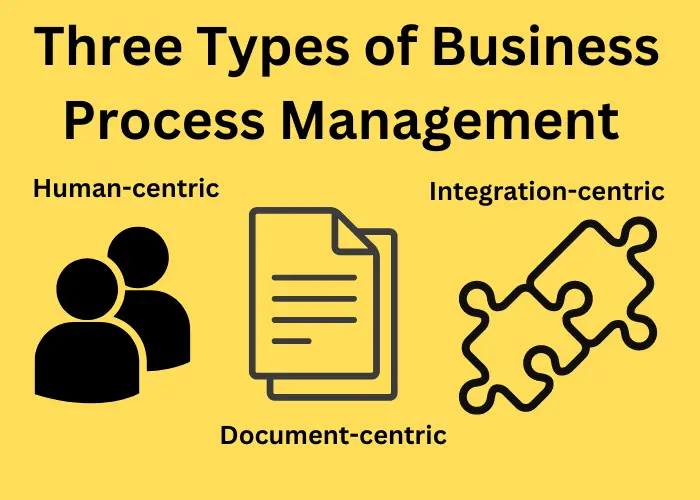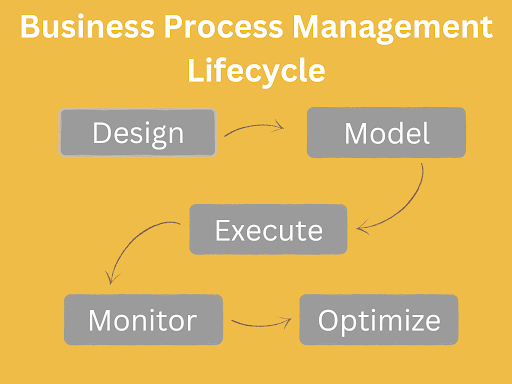
Business process management, or BPM, is a systematic approach to improving the efficiency and effectiveness of business processes within an organization to achieve specific or improved business goals. There are different types of BPM, and to be effective, they must be tailored to the needs of an organization and the industry in which it operates.
However, there are clear stages, also known as the BPM lifecycle, all businesses should go through when implementing business process management. Following the protocol will help guide the organization through its operations.
In this article, we’ll define the types of BPM and explain how you can navigate stages in the lifecycle successfully. We’ll also explore how business process management systems can aid in this process.
The Three Types of Business Process Management
Before we discuss the five phases of the business process management lifecycle, understanding the different types of business process management is important. BPM can be categorized into three main types, each with its unique characteristics and applications.

Human-centric BPM
Human-centric BPM revolves around processes that require significant human involvement. These are typically creative processes where human decision-making is crucial. For instance, customer service processes where representatives handle customer complaints are examples of human-centric BPM.
Document-centric BPM
This category focuses on processes involving paper- and electronic-based documents. These processes must be managed meticulously, adhering to the company’s policies, industry standards, and regulatory requirements. For example, legal and accounting processes that involve routing contracts and agreements for review and signoff are document-centric.
Integration-centric BPM
Sometimes known as System-centric BPM, this type of business process management is all about the fusion and automation of systems, such as Enterprise Resource Management (ERP), Customer Relationship Management (CRM), and Human Resource Management Systems (HRMS) applications.
Integration-centric BPM boosts user productivity and satisfaction by facilitating rapid access to apps, data, and services through connectors and APIs.
A practical example of integration-centric BPM is the use of interconnected tools for campaign management, lead analytics, and CRM by marketing and sales teams. This approach often involves system integrations and automated workflows to enhance efficiency.
What is the Business Process Management Lifecycle?
The BPM lifecycle is comprised of five phases (aka stages): process design, modeling, execution, monitoring, and optimization. Each phase of the lifecycle builds on the previous one, and the result is an efficient and effective business process management system that meets the needs of the business. By following the BPM lifecycle, organizations can ensure that their business processes are continuously improved and aligned with their strategic goals.

The Five Stages of Business Process Management
Let’s take a look at each stage of the BPM lifecycle in more detail:
Design
The process design stage is the foundation of a successful BPM initiative and is all about understanding the current state of your business processes and developing an improvement plan. This begins with identifying the goals you want to achieve and determining which processes need to be redesigned to meet those goals.
Questions to ask include:
- What are our business goals?
- What processes need to be improved to meet those goals?
- What are the current pain points in the business process?
- What is the current state of our process?
- Who should be involved in the process design stage?
- Are there any new processes that need to be introduced to achieve these goals?
The design stage should involve a cross-functional team of stakeholders responsible for the redesigned processes. This includes business analysts, process owners, and subject matter experts. The design stage can also include creating a business case for the BPM initiative that outlines the expected benefits and costs.
The design stage is vital because it allows businesses to think about their processes holistically and identify ways to optimize them.
Model
After you have analyzed your business processes in step one, it is time to start modeling them in step two.
The first thing you need to do when modeling your business processes is to identify the inputs and outputs of each process. Inputs are anything that goes into the process, such as raw materials or information. Outputs are anything that comes out of the process, such as finished products or services.
To map out the entire process and steps in detail, you will need to create a flowchart. A flowchart is a diagram that shows the steps in a process in sequential order.
It is often helpful to map out how the process performs in different scenarios. For example, what happens if an order is canceled? Or if a customer requests a refund? By mapping out these different paths, businesses can get a clear picture of how their process currently works and where there is room for improvement.
Once you have created a flowchart for each business process, it is time to consider how each process can be automated. Automation can improve efficiency by reducing errors and freeing employees to focus on value-added activities. When evaluating the tasks involved, consider whether they are repetitive, rules-based, or well-defined.
Finally, once you have modeled your business processes and considered automation, it is time to evaluate whether the processes are essential or can be eliminated altogether. This can be done by comparing the costs and benefits of each process.
Once the new model has been created, it’s time to move on to the next stage.
Execute
Implementing the business process is the third stage in the business process management methodology. This is where you take all of the planning and theoretical work that’s been done and put it into action.
Before fully implementing the new process, testing it out on a small scale is essential to ensure that it works as intended. This will help identify potential problems and allow for adjustments before rolling it out company-wide.
Monitor
To effectively monitor your business processes, you need to establish a set of metrics and Key Performance Indicators (KPIs) to track. These will vary depending on the type of business and the specific processes you are trying to improve. However, some common examples include cycle time, customer satisfaction, error rates, and throughput.
You can identify potential bottlenecks or areas needing improvement by monitoring these metrics. Once identified, these areas can be optimized, which takes us to our final stage in the business process management lifecycle.
Optimize
Congratulations! You’ve made it to the final stage of the business process management lifecycle.
The optimization stage is about continuously improving the business processes that have already been identified, documented, and analyzed. The goal at this stage is to continue making the business processes more effective and streamlined.
Process optimization is important because it can help businesses achieve their desired outcomes while also reducing costs. In today’s competitive business landscape, companies must continually strive to find ways to do more with less.
Ensuring Smooth Transitions Between BPM Stages
Transitioning smoothly between the stages of the Business Process Management lifecycle will help with maintaining momentum. Here are some strategies to facilitate these transitions.
- Clear Communication – Keep all involved informed regarding progress and the upcoming transition to the next stage. This includes explaining what the next stage involves and what their roles will be, and how it contributes to the overall process.
- Invest in Training – Providing your team with the necessary training for each stage of the BPM lifecycle will make for a more efficient and effective transition between each phase.
- Conduct Regular Reviews – At the conclusion of each stage, take the time to review the process. Reflect on the successes, identify the challenges encountered, and use these insights to refine your approach for the subsequent stages.
The Impact of Organizational Culture on the BPM Stages

Organizational culture will greatly influence the implementation and success of business process management. It’s an invisible force that permeates each stage of the BPM lifecycle, subtly steering the direction and outcomes of process management efforts.
A culture that values collaboration and open communication can enhance the design and modeling stages of BPM, where diverse inputs and perspectives are crucial. Similarly, an organization’s adaptability to change can determine the success of the execution and optimization stages, where change is inherent and continuous improvement is sought.
A business culture that empowers its employees also amplifies the effectiveness of each BPM stage. When employees feel valued and involved, they are more likely to contribute their best efforts.
In essence, while organizational culture profoundly impacts BPM stages, the process of implementing BPM can also shape the culture, fostering a more collaborative, adaptable, and improvement-focused environment.
BPM and Project Management: Complementary, Not Identical
Understanding the five stages of the BPM lifecycle is important, but it doesn’t quite cover the whole picture. Knowing the difference between Business Process Management and Project Management – often an area of confusion – is key. While they both aim to streamline operations and achieve business goals, they serve different purposes and require unique approaches.
BPM is not a software product but a management practice. While there are BPM platforms available (HighGear being a great example) that aid in implementing standard and automated business processes, BPM itself is not a software product.
It’s a systematic approach to optimizing business processes. BPM is focused on repetitive and ongoing processes that follow a predictable pattern. It’s about continuous process improvement and ensuring that these processes align with the organization’s strategic goals.
Project Management is about handling and organizing a set of activities or tasks. It involves the use of project management software like Microsoft Project or Jira. Unlike BPM, Project Management is not focused on repetitive and ongoing processes but on unique, temporary projects with a defined start and end date.
Best Practices for Successful BPM Implementation with HighGear

Implementing BPM can markedly transform organizational operations but necessitates a well-planned strategy. Here are some best practices to help you win at BPM implementation with HighGear.
- Involve Key Stakeholders Early – Their input and buy-in are crucial for the success of BPM initiatives. HighGear’s platform allows for collaborative process design and decision-making, ensuring everyone is on the same page.
- Prioritize Processes for Improvement – Not all processes are created equal. Some will have a greater impact on your business outcomes than others. Work with the HighGear team to help identify and prioritize these processes based on factors like cost, impact on customer satisfaction, and alignment with business goals.
- Leverage Automation Where Possible – HighGear’s platform offers powerful automation capabilities. Use these to eliminate manual tasks, reduce errors, and free up your team to focus on more strategic, value-added activities.
- Continuous Monitoring and Improvement – BPM is not a one-time project but an ongoing effort. HighGear’s real-time monitoring capabilities allow you to track process performance and identify areas for improvement continuously.
- Training and Support – Ensure your team has the necessary training to use the HighGear platform effectively. HighGear University and the support team work extensively to build success in the platform. Also, provide ongoing support internally by building key “go-to” experts who are available to help users overcome any challenges they may encounter.
- Embrace Change Management – Implementing BPM often involves significant changes to existing processes. Use change management strategies to help your team understand and adapt to these changes.
- Iterate and Improve – Finally, remember that BPM is a journey, not a destination. Use HighGear to continuously iterate and improve your processes based on feedback and performance data.
By following these best practices and leveraging the power of HighGear, you can ensure your BPM initiative is a success and delivers tangible benefits to your organization.
In Conclusion
Business process management is an iterative process, meaning businesses can and should continually revisit each stage to improve their processes continuously. By doing so, businesses can stay ahead of the competition and ensure they’re always providing the best possible service to their customers.
